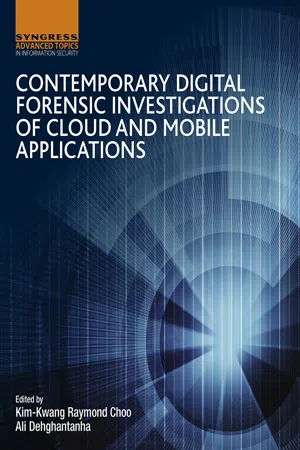
Contemporary Digital Forensic Investigations of Cloud and Mobile Applications
- 326 pages
- English
- ePUB (mobile friendly)
- Available on iOS & Android
Contemporary Digital Forensic Investigations of Cloud and Mobile Applications
About This Book
Contemporary Digital Forensic Investigations of Cloud and Mobile Applications comprehensively discusses the implications of cloud (storage) services and mobile applications on digital forensic investigations. The book provides both digital forensic practitioners and researchers with an up-to-date and advanced knowledge of collecting and preserving electronic evidence from different types of cloud services, such as digital remnants of cloud applications accessed through mobile devices.
This is the first book that covers the investigation of a wide range of cloud services. Dr. Kim-Kwang Raymond Choo and Dr. Ali Dehghantanha are leading researchers in cloud and mobile security and forensics, having organized research, led research, and been published widely in the field. Users will gain a deep overview of seminal research in the field while also identifying prospective future research topics and open challenges.
- Presents the most current, leading edge research on cloud and mobile application forensics, featuring a panel of top experts in the field
- Introduces the first book to provide an in-depth overview of the issues surrounding digital forensic investigations in cloud and associated mobile apps
- Covers key technical topics and provides readers with a complete understanding of the most current research findings
- Includes discussions on future research directions and challenges
Frequently asked questions
Information
Contemporary Digital Forensics Investigations of Cloud and Mobile Applications
† University of South Australia, Adelaide, SA, Australia
‡ University of Salford, Salford, United Kingdom
Abstract
Keywords
Table of contents
- Cover image
- Title page
- Table of Contents
- Copyright
- Contributors
- About the Editors
- Chapter 1: Contemporary Digital Forensics Investigations of Cloud and Mobile Applications
- Chapter 2: Forensics Analysis of Android Mobile VoIP Apps
- Chapter 3: Investigating America Online Instant Messaging Application: Data Remnants on Windows 8.1 Client Machine
- Chapter 4: Forensic Investigation of Social Media and Instant Messaging Services in Firefox OS: Facebook, Twitter, Google+, Telegram, OpenWapp, and Line as Case Studies
- Chapter 5: Network Traffic Forensics on Firefox Mobile OS: Facebook, Twitter, and Telegram as Case Studies
- Chapter 6: Mobile Phone Forensics: An Investigative Framework Based on User Impulsivity and Secure Collaboration Errors
- Chapter 7: Performance of Android Forensics Data Recovery Tools
- Chapter 8: Honeypots for Employee Information Security Awareness and Education Training: A Conceptual EASY Training Model
- Chapter 9: Implications of Emerging Technologies to Incident Handling and Digital Forensic Strategies: A Routine Activity Theory
- Chapter 10: Forensic Readiness: A Case Study on Digital CCTV Systems Antiforensics
- Chapter 11: Forensic Visualization: Survey and Future Research Directions
- Chapter 12: Investigating Storage as a Service Cloud Platform: pCloud as a Case Study
- Chapter 13: Cloud Storage Forensics: Analysis of Data Remnants on SpiderOak, JustCloud, and pCloud
- Chapter 14: Residual Cloud Forensics: CloudMe and 360Yunpan as Case Studies
- Chapter 15: An Android Cloud Storage Apps Forensic Taxonomy
- Index